The Difference Between MPEG2 and MPEG4 [What is the Best?]
Do you love watching videos on Television, computer, mobile phones, or tablets? But what type of video file format are you watching? There are a lot of video and audio formats, and one of these is MPEG. What is the meaning of MPEG? MPEG stands for the Moving Pictures Experts Group, a file format for compressing video images and audio. It was created by ISO and IEC and established in 1988 by Hiroshi Yashuda and Leonardo Chiariglione. The MPEG organizations produced seven digital media standards: MPEG 1, MPEG 2, MPEG 4, MPEG 7, MPEG-MAR, and MPEG-DASH. Using this compression can lessen the file size but will lose quality. In this article, you will learn what is the difference between MPEG 2 and MPEG 4.
Part 1. MPEG 2 MPEG 4 Differences
What is MPEG2?
The digital television and DVD video standard is MPEG 2. It was produced in 1995 by the ISO and IEC. Digital television, DVDs, VCDs, and other such discs, were chosen as the compression strategy. It is also created to fix the shortcomings of MPEG 1. The File Extensions usually using MPEG 2 are .mpeg, .m2v, .mp2, mp3, and .mpg. You can enjoy using MPEG 2 because of its advantages. These benefits include superior and sustained quality compared to other video formats, a simple method of video compression, and the ability to handle video streams from regional broadcasts and DVDs. Also, it has a bitrate range of 5 to 8 Mbits/sec and requires broader bandwidth. It is usually up to 40 MB/second.
What is MPEG4?
MPEG 4 was created in 1998 as multimedia standards for computers, mobile devices, and the web. It supports IPMP, also known as Intellectual Property Management and Protection, which manages and protects content. This method reduces the file size of an audio and video file but retains its quality and supports up to 4Mbps. It is excellent support for content in 2D and 3D. MPEG 4 is what broadcasters need when distributing content IP and allowing them to browse easily. The advantages of this are that it supports all kinds of interactivity, has a comprehensive range coverage of bit rates, qualities, applications, services, and resolutions, and integrates both synthetic and natural content in object form. The File Extensions usually using MPEG 4 are .mp4, .m4a, .m4b, .m4r, and .m4v.
What is the Difference Between MPEG 2 and MPEG 4?
MPEG 2 vs. MPEG 4 - Quality
MPEG 2 produces better video quality than MPEG 4. Unfortunately, due to the large file size, it is not suitable for the internet, multimedia applications, and online streaming. But it can handle video streams from local sources like DVDs and broadcast applications. MPEG 4 provides high-quality video and audio over multimedia streaming applications on the internet. It produces smaller file sizes and has high rates of compression.
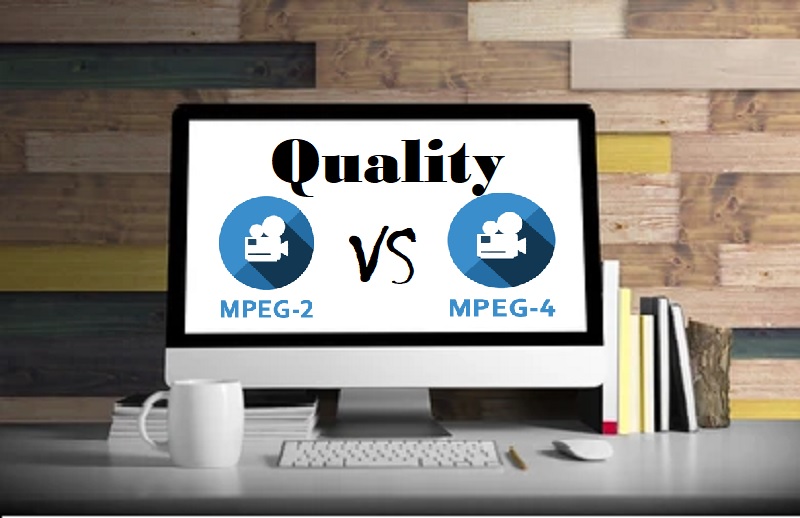
MPEG 2 vs. MPEG 4 - Compression
Video or audio compression is about maintaining the same quality of video and audio, and both can maintain it. MPEG 4 uses H.264 encoding, which is much more compressed because of the superior compression algorithm. The file can be lossless because of the smaller file size. MPEG 2 uses H.262 encoding, simplifying the compression more than MPEG 4. It uses lossy video compression and lossy audio data compression methods.
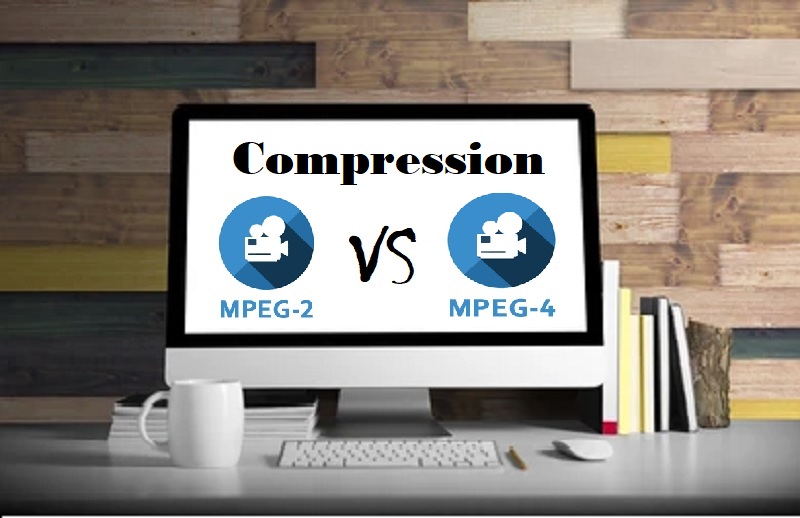
MPEG 2 vs. MPEG 4 - Bit Rate & Bandwidth
The bitrate of MPEG 2 ranges from 5 to 80 Mbits/sec, which is higher than MPEG 4, just some Kilobytes per second only. MPEG 2 requires a higher bandwidth of 40 MB per second because of its large size compared to MPEG 4, which has a bandwidth of around 64kbps.
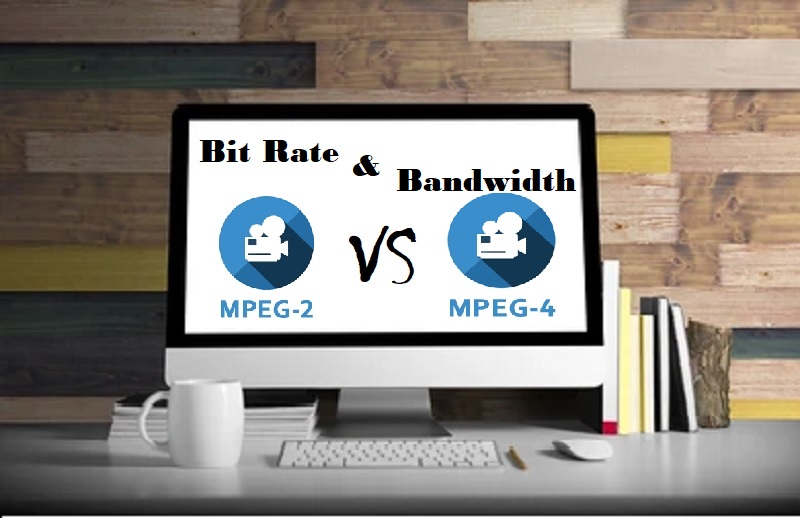
Part 2. How to Convert MPEG 2 and MPEG 4 to Other Format
Top Feature: It has a comprehensive program that functions as a video converter, editor, and downloader.
Latest Updated Features: The latest features that AceThinker Video Master has are GIF Maker, Video Compressor, and Media Metadata Editor.
Best for: It is best for editors or users that want to convert their videos to another format.
AceThinker Video Master is a multi-functional tool converter that can convert MPEG 2 and MPEG 4 to another format or vice versa. The primary function of this tool is to change the format of the video file. Also, if you want to be compatible with your video on another platform where you want to upload it, you can use this tool. It supports video and audio formats such as MOV, WMV, FLV, MKV, MPEG2, MPEG4, and other available formats. You can also modify 4K UHD and HD 1080P while the original platform can remain. Other than that, it does not restrict users with its function.
Step 1. Import a MPEG 2 or MPEG 4 Video File
If you already have the AceThinker Video Master, the first thing you need to do is to add a video file. There are three ways to import a video file. First, click "Converter," and you will see the "Add Files" click the drop-down and see the Add Files or Add Folder under it. Another one is the "+" sign; click that, and the File Manager will pop up. Lastly, drag your file directly into the app.
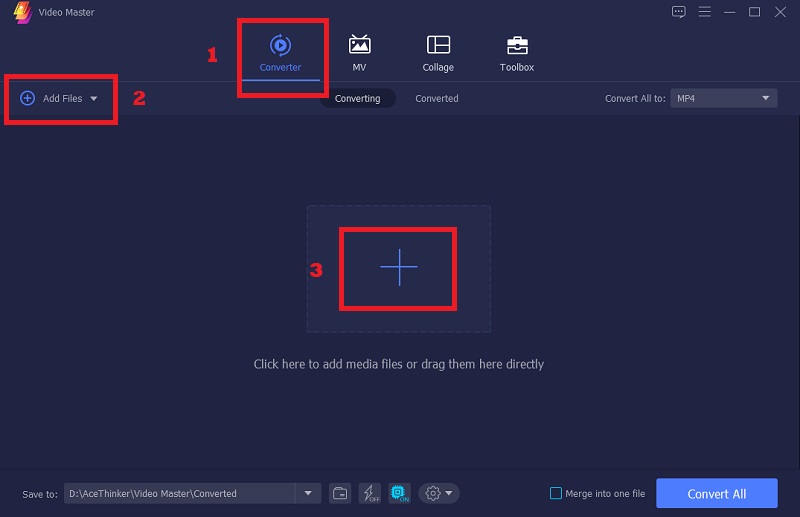
Step 2. Convert the Video File
Once you've added the file, you can choose the format you want to convert your video. Click the drop-down button to "Convert All to," and you can see the available formats. Then, click "Convert All" to start converting and wait until it finishes.
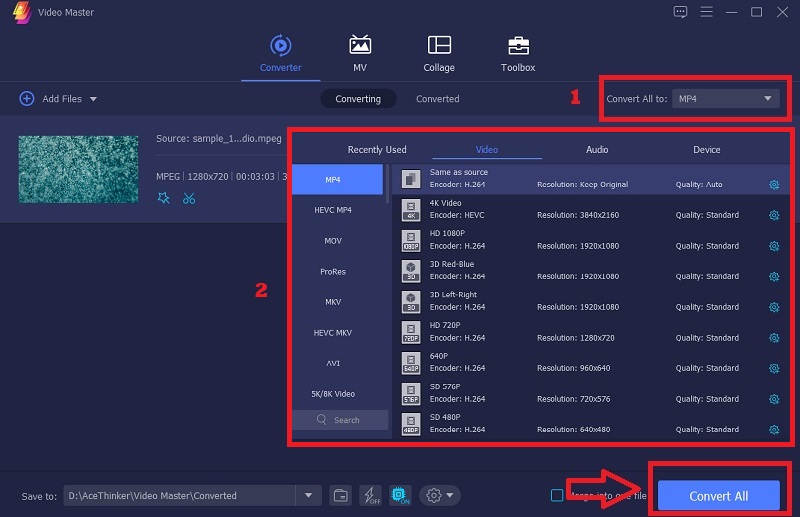
Step 3. Play and Preview
When done, the File Manager will pop up on your screen, and you can see where the converted file is located because it saves automatically. To confirm that the conversion is successful, right-click the mouse on your video and find "Properties," and you will see the "Type of File" under that. Then, you can watch your video.
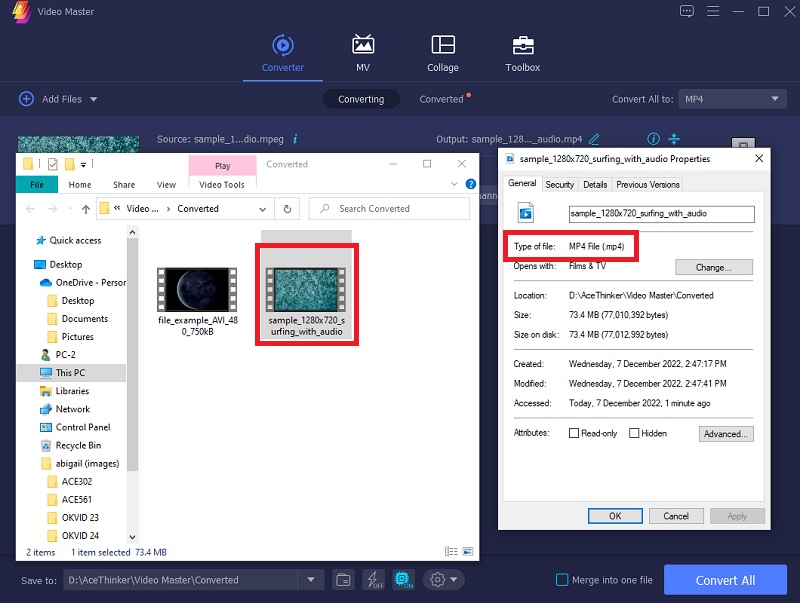
Part 3. Comparison Chart
|
File Size |
Application |
Disadvantages |
| MPEG 2 |
MPEG 2 has a large file size of up to 4GB. |
DVDs and Television Broadcast |
It requires installing a codec for Windows playback. |
| MPEG 4 |
Video Files are much smaller in size that can produce a full-length movie file that is less than 1GB. |
Portable Devices and Internet Streaming |
It doesn’t play on other devices and platforms. |





